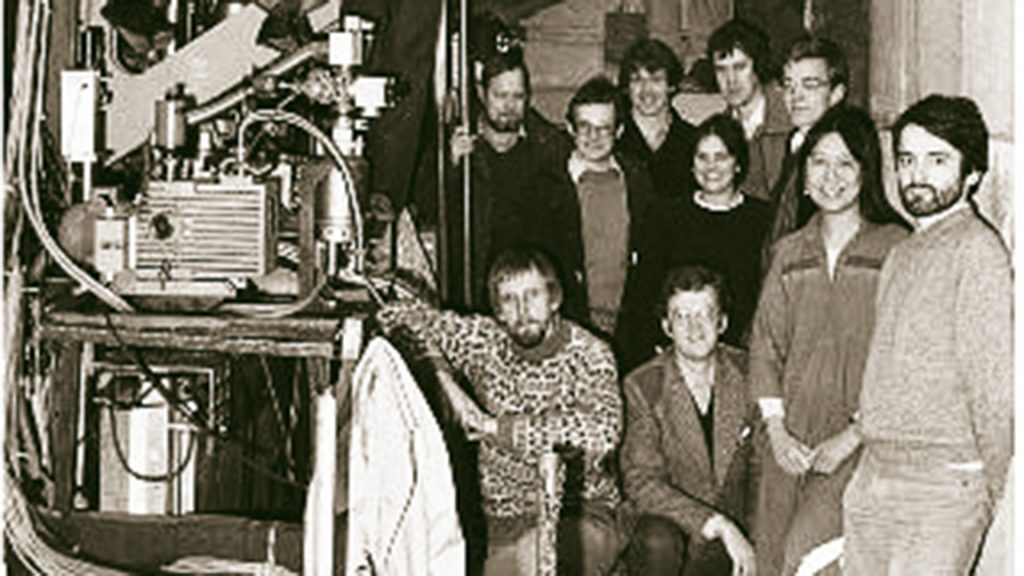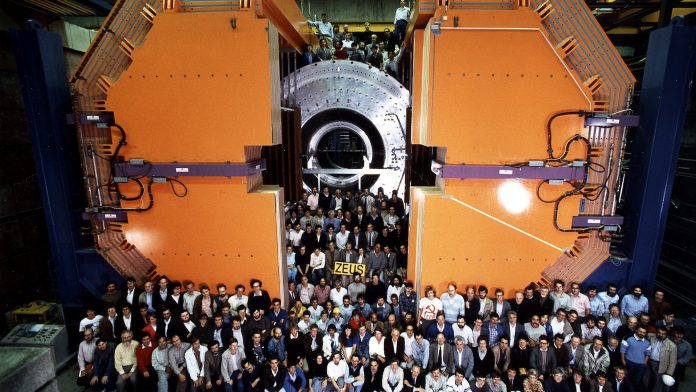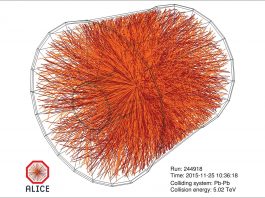Professor Brian Foster OBE, FRS draws observations from his career as a physicist, from studying at Oxford to the International Linear Collider (ILC) and beyond.
I was the first of my family to go to university, Queen Elizabeth College, part of the University of London that emerged from Kings College before being subsequently reabsorbed by it. On the day of my interview for a D. Phil studentship at Oxford, the department was distracted by the news that a narrow resonance had been seen in electron-positron collisions at SLAC. The implications of the discovery of the charm quark in the ‘November revolution’ took a considerable time to be digested and indeed had almost no effect on my D. Phil. studies.
I became a member of the Amsterdam-CERN-Nijmegen-Oxford collaboration, studying negative kaon-proton interactions in the CERN 2m bubble chamber. A great many of the specific skills I developed during my D. Phil. did not figure in my subsequent career. What was essential, however, was my experience of how to work in a team, under minimal supervision, and, towards the end of my three years, taking responsibility for leading the Oxford activity in the collaboration.
TASSO
After graduating, I moved a few miles away to the Rutherford Appleton Laboratory to join David Saxon’s group. We were responsible for the time-of-flight counters of the TASSO experiment. A few months calibrating these with electrons from the 14 MeV Betatron propelled me towards the detector development that characterised the first part of my career. Once we had taken the detectors to Hamburg, I joined the small team working on data acquisition. Pushing the speed limits of our Nord 10S/Nord 100 computer system to its limit, most of our work had to be done in machine code, and some even in binary. At least the words were only 16-bits long. The basic memory was 64K – although that could be increased to 256K via paging. We controlled the whole experiment with 16 levels of interrupt and the memory corresponding to about 30 seconds of a Beethoven symphony in a modern recording.
Very quickly, TASSO started to produce results. The leading lights were Guenter Wolf, the spokesperson, Bjorn Wiik, Paul Soeding, Erich Lohrmann, Sau Lan Wu, and Roger Cashmore. I had known Roger in Oxford, where he helped me with partial wave analysis, beginning what became a life-long collaboration.
As I was working on DAQ in the Control Room one day, I could see Sau Lan and Bjorn at the corner desk, event displays scattered around, fitting templates drawn on mylar transparencies. The track reconstruction software wasn’t yet working, but it was already clear that there was an interesting class of events that departed from the normal two-jet structure from quark-antiquark pairs.
What was the third jet? Quantum chromodynamics was in its infancy but before long we felt confident enough to despatch Bjorn to Oslo to announce evidence for the gluon. It wasn’t yet a discovery, but it looked very suggestive.
Before long, other experiments chimed in and the gluon took its place in the particle physics pantheon. We went on to measure its spin, its fragmentation properties, and had a wonderful time exploring electron-positron physics. Despite being certain it was just around the energy corner, however, we never did find the top quark!
I worked with David Binnie to install a high-pressure vertex detector as a TASSO upgrade. I learnt a lot about how to design a high-precision gaseous detector from scratch; the VXD worked well, allowing TASSO to study heavy quarks and leptons in detail.

ELECTRA, the SDC, and more
The next step seemed to be the Large Electron-Positron (LEP) at CERN. Many TASSO collaborators, led by Roger Cashmore, joined others in proposing ELECTRA. I spent countless nights running Monte Carlo simulations of the detector while the remaining hours were taken up with TASSO analysis and looking after the VXD.
ELECTRA was not selected, but I nevertheless learned how one goes about designing large collider experiments. This turned out to be very useful for another failed proposal, the SDC experiment at the Superconducting Supercollider (SSC). This failed in a different way to ELECTRA; the SDC was accepted into the experimental programme but in 1993 the SSC itself was cancelled.
By then, I had been a faculty member at Bristol for around a decade, also working on preparations for the ZEUS detector studying electron-proton interactions at DESY’s HERA accelerator. Once again under Roger Cashmore’s leadership, I was responsible for producing the electronics for the ZEUS Central Tracking Detector. The detector itself was constructed in Oxford by a large collaboration of UK institutes. This was a very challenging project, especially the pipelined trigger and pulse digitisation with Flash ADCs.
Again, Guenter and Erich were among the leaders, together with Robert Klanner, Frank Sciulli, Wesley Smith, and John Martin. I had the honour of succeeding Allen Caldwell as Spokesman of ZEUS from 1999-2003. This was the happiest and most fulfilling period of my career, particularly as my family could join me in Hamburg. My spokesmanship coincided with the HERA upgrade which, after a scare with background levels that took me back to my early work on collimators for TASSO, was a success. Despite a couple of false alarms, we saw no new physics, but the HERA structure functions will be in the textbooks for decades to come. I am still working on ZEUS, more than 13 years after we stopped taking data. Interesting analyses continue to emerge, often in combination with our sister experiment, H1.
I became a member of the BaBar Collaboration after the demise of the SSC. The UK groups were working on the electronics for the Ceasium-Iodide calorimeter. I had to leave BaBar just before the data began to flow in order to take over the ZEUS Spokesmanship. Various time-consuming roles in UK science administration meant I did not get as involved with BaBar as I would have liked. I also succeeded Lorenzo Foa as Chair of the European Committee for Future Accelerators in 2002. Our visitations to the CERN Member States and subsequent recommendations to the appropriate government ministry sometimes led to pleasing results.
I returned to Oxford in 2003, taking over as head of the particle physics department in 2004 and becoming Donald H. Perkins Professor of Experimental Physics. Donald Perkins had been head of particle physics when I was a student. He is another of the brilliant physicists who have shaped my career.
The International Linear Collider (ILC)
At the end of my term of office as ECFA Chair in 2005, I found myself nominated to be European Director for the Global Design Effort of the International Linear Collider (ILC), led by Barry Barish. In this role, I had to do a crash course in accelerator physics. I found this interesting enough that gradually most of my research moved, firstly into superconducting radio-frequency cavities and then to plasma wakefield acceleration. This transition was lubricated by the award of an Alexander von Humboldt Professorship at University of Hamburg/DESY, for which Albrecht Wagner, DESY Director, urged me to apply.
Most of the €5m of funding went towards the construction of the FLASHForward beamline, where I currently work and which is producing exciting results in beam-driven plasma-wakefield acceleration. The quest to build the ILC goes on; we have morphed into our third organisational structure, trying to convince the Japanese government to take the crucial first step towards construction.
From reflecting on some of my experiences, I believe that a particle physicist should ideally be running and extracting physics from an experiment while simultaneously planning or building the next one. As my career has progressed, the time between major collider projects at the energy frontier has become longer and longer. This, combined with the pressure to publish, makes it increasingly difficult for younger physicists to find the time to do the simulations and design work for new experiments. Most of the experimental proposals I have worked on have not been built; it would be difficult now to justify a similar number of ‘failures’ on a young person’s CV. Failure, however, is a concomitant to eventual success.
Sociological problems
The very large collaborations at, for example, the Large Hadron Collider (LHC) are causing sociological problems. This is not within the particle physics community, where ‘microbunching’ (my colleagues at the AWAKE plasma wakefield experiment at CERN can explain) spontaneously occurs and teams on particular topics tend to a manageable size. Rather, the problem is with our fellow scientists in other disciplines, who cannot resolve an individual’s brilliance. It has become impossible for authors even to read all the papers that they sign. I have experienced how difficult it is to defend this in the increasingly frequent government-led exercises that compare science across broad fields. The principle that everyone who designs, builds, and operates a detector, as well as those doing analysis, gets credit is a good one. We need to adapt it by assigning each collaborator a fraction of the produced papers a year, allowing them to select which they sign as they appear, moving us back towards the mainstream of scientific practice.
Leading the way in international collaboration
My career has centred on the energy frontier, where there is a consensus that the next collider should be an electron-positron ‘Higgs factory’, to allow us to probe the properties of that most mysterious and unique of particles, the Higgs Boson. CERN needs a new project, a ‘safe option’ that is both technically feasible and affordable to start construction sometime in the 2030s to succeed the marvellously successful Higgs discoverer, the LHC.
It has an ‘aspirational option’ – the Future Circular Collider (FCC), both in the electron-positron and the proton-proton modes. It is aspirational because the former cannot be afforded from the current funding base and the latter is both unaffordable and not yet technically feasible; many years of magnet development will be required.
Building the FCC will require a truly global organisation. Thus, the time is ripe for particle physics once again to lead the way in international collaboration, as it did when the European countries came together to form CERN in 1954. CERN could have a ‘safe option’ that is demonstrably technically feasible by constructing the ILC, or CLIC, itself. Much preferable though would be for CERN to embrace current associates such as Japan, the USA, and China, thereby transforming itself from a de facto global organisation into de jure.
I concur with a suggestion made to me by my friend and colleague Steinar Stapnes concerning implementation of the ILC. If Japan joined CERN as a full member, the expanded CERN would supervise the construction of the ILC in Japan as a CERN remote site. The cost to Japan of the CERN subscription would be similar to the cost of hosting ILC ‘stand-alone’, with much less risk. This would also allow the time and eventually the resources for the ‘aspirational option’ to come to fruition. It will not be easy and it will take time, but so will building ILC alone. A CERN, expanded to embrace all nations currently collaborating in particle physics, would ensure a brilliant future for the subject.
I was struck by a remark that my old friend Al Goshaw made in these pages some time ago, a ‘reminder that beyond the scientific return, the CERN laboratory has a societal impact by providing an example of what humanity can achieve when politics falls away and instead there is co-operation across nationalities and cultures.’
We did it once before, when CERN was founded. The time has come to take the next step.
Professor Brian Foster OBE, FRS
Donald H. Perkins Professor of Experimental Physics
University of Oxford
brian.foster@physics.ox.ac.uk
www.physics.ox.ac.uk/our-people/fosterb
https://twitter.com/oxfordphysics?lang=en
Please note, this article will also appear in the eighth edition of our quarterly publication.









